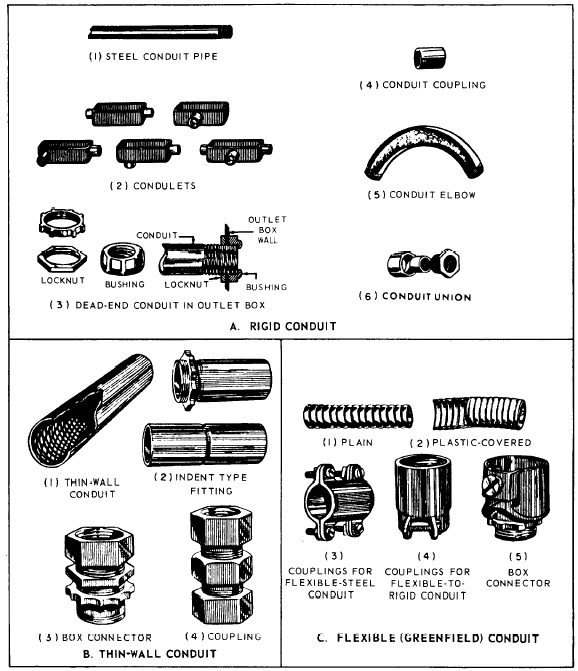|
Conduits and Fittings An electrical conduit is a pipe, tube, or other means
in which electrical wires are installed for protection
from accidental damage or from the elements.
If pipes or tubing is used, the fittings depend
upon the pipe or tubing material. The conduit
used in Navy construction is generally classified as RIGID, THIN-WALL, or FLEX-
IBLE conduit. The three types of conduit and their associated fittings are shown
in figure 9-15.
RIGID CONDUIT. Rigid
galvanized steel or aluminum
conduit is made in 10-ft lengths. It is threaded
on both ends and comes with a coupling
on one end. It comes in sizes from 1/2
in. to 6 in. in diameter. Various fittings used

Figure 9-15.-Types of conduit and
their associated fittings.
for connecting rigid metal conduit are shown in figure
9-15, view A. The use of rigid conduit involves
a good deal of cutting, bending, and threading
of lengths. An ordinary hacksaw or special
wheel pipe cutter is used for cutting, while a
ratchet type of mechanical die is used for thread-cutting conduit
pipes. Bending of pipes can be undertaken
both manually, using a bending tool commonly
called a hickey, and hydraulically. A hydraulic
bender is recommended for making smooth
and accurate bends.
CONDULETS (fig. 9-15, view A (2)) are a convenient
way of making bends, especially in conduit
that will be exposed to the elements. They are
heavily used on sharp corners and also to reduce
the number of bends made in a run of conduit.
Another type of rigid conduit approved for use
by NAVFAC is the polyvinyl chloride (PVC) pipe.
This now popular plastic conduit is specially suitable
for use in areas where corrosion of metal conduits
has been a problem. Some of the advantages
of PVC conduit are as follows: light handling
weight, ease of installation, and leakproof
joints. This conduit is primarily intended
for underground wire and cable raceway use
and is made in two forms. Type I is designed for
concrete encasement, and Type II is designed for
direct earth burial. Rigid plastic conduit and fittings
are joined together by a solvent-type adhesive
welding process. It also comes in sizes of
1/2 to 6 in. in diameter. PVC fittings are also available
from the manufacturer. (For more information
on PVC fittings, refer to Article 370 of
the NEC .)
|
|

